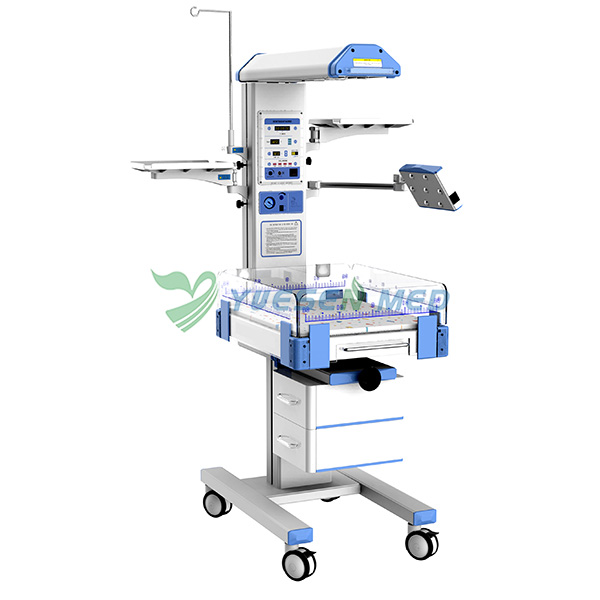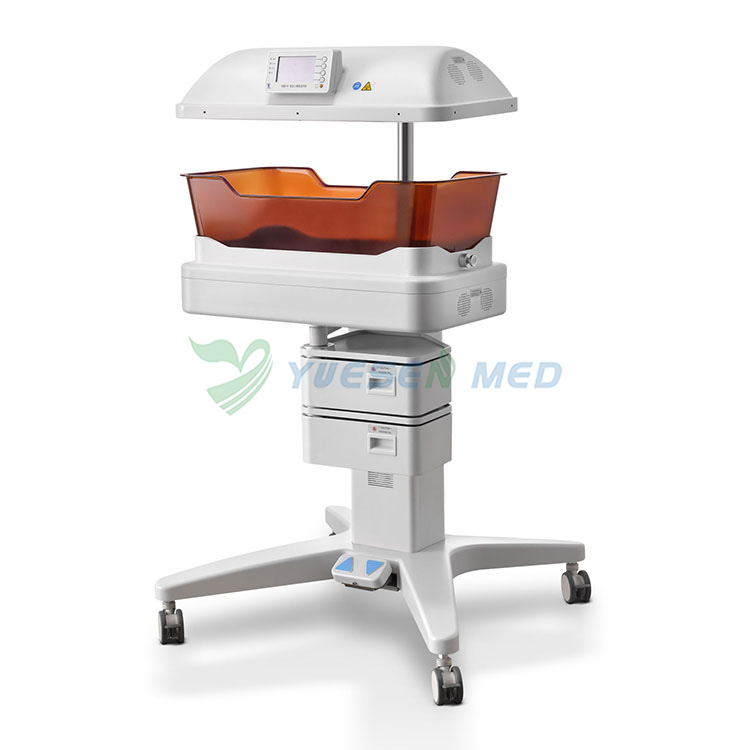Hot Products
YSX500D 50kW DR system set up and put into service in Cambodia.
YSENMED YSX500D 50kW digital x-ray system has been successfully set up and put into service in a hospital in Cambodia.
YSX056-PE serving as a vehicle-mounted x-ray in the Philippines
YSX056-PE 5.6kW portable x-ray unit has been adapted to fit on a truck, to provide mobile x-ray examination service for remote communities in the Philippines.
X Ray Machine To Zimbabwe
x ray machine, 50KW x ray machine
Microscope To Malawi
Achromatic objectives: 4X、10X、40X(S), 100X(S、Oil) Wide field eyepiece: WF10X(WF16X for option) Eyepiece head: Sliding binocular head inclined at 45° Stage: Double layer mechanical stage size 140X140mm, moving range 75X45mm Focusing: Coaxial coarse and
What is the Difference Between Radiant Warmer and Phototherapy?
Views : 4450
Update time : 2025-04-19 10:57:00
When it comes to caring for newborns, especially those who are preterm or have certain medical conditions, two common methods often come into play: radiant warmers and phototherapy. While both are crucial in neonatal care, they serve different purposes. So, let's dive into the nitty-gritty of these two techniques and explore how they differ, their uses, and when each is appropriate.

- Preterm Birth: Premature babies often struggle to maintain their body temperature due to a lack of body fat.
- Low Birth Weight: Babies with low birth weight require additional warmth to support their metabolic needs.
- Medical Procedures: When a baby needs immediate medical attention, radiant warmers provide warmth without hindering access.

- Physiological Jaundice: Common in newborns, it usually resolves on its own but may require treatment if levels are too high.
- Pathological Jaundice: This occurs when jaundice appears within the first 24 hours after birth or persists beyond the typical time frame.
- Hemolytic Disease: Conditions like Rh or ABO incompatibility can lead to severe jaundice that necessitates phototherapy.
- Phototherapy: Specifically aimed at treating jaundice.
- Phototherapy: Utilizes blue light to break down bilirubin.
- Phototherapy: Often involves a light source positioned above or beside the baby.
- Phototherapy: Targets elevated bilirubin levels in the blood.
- Phototherapy: Typically requires specific sessions based on bilirubin levels.
- Overheating: If not monitored properly, there's a risk of overheating, which can lead to complications.
- Dry Skin: Prolonged exposure to heat can cause skin dryness.
- Skin Damage: Prolonged exposure to light can lead to skin irritation or burns if not managed correctly.
- Eye Protection: Babies require eye protection during treatment to prevent damage from the light.
So, the next time you hear about radiant warmers or phototherapy, you'll know exactly what they are and why they matter. Whether you're a healthcare professional or a curious parent, this knowledge can help you appreciate the intricate care that goes into ensuring the health of our tiniest humans.
Understanding Neonatal Care
Before we get into the specifics, let's take a moment to understand why neonatal care is so vital. Newborns, particularly those born prematurely, have immature systems that struggle to regulate temperature and may face challenges like jaundice. Proper care can make a world of difference in their health outcomes.What is a Radiant Warmer?

The Basics of Radiant Warmers
A radiant warmer is a device designed to provide a controlled and warm environment for newborns. It consists of a heating element, usually located above the baby, that radiates heat directly onto the infant. This method helps maintain the baby's body temperature, which is crucial for their survival and overall health.How Do Radiant Warmers Work?
Radiant warmers use infrared radiation to transfer heat. Unlike traditional incubators, which enclose the baby in a warm environment, radiant warmers allow for easy access to the infant while still providing warmth. This setup is especially useful during procedures like examinations or when the baby needs to be fed.When Are Radiant Warmers Used?
Radiant warmers are commonly used in various situations, including:- Preterm Birth: Premature babies often struggle to maintain their body temperature due to a lack of body fat.
- Low Birth Weight: Babies with low birth weight require additional warmth to support their metabolic needs.
- Medical Procedures: When a baby needs immediate medical attention, radiant warmers provide warmth without hindering access.
What is Phototherapy?

The Basics of Phototherapy
Phototherapy is a treatment method primarily used for newborns with jaundice, a condition characterized by high levels of bilirubin in the blood. This treatment involves exposing the baby to specific wavelengths of light, which helps break down bilirubin in the skin.How Does Phototherapy Work?
Phototherapy works by using blue light, which is effective in converting bilirubin into a form that can be easily eliminated from the body. The light penetrates the skin and helps reduce bilirubin levels, thus treating jaundice.When is Phototherapy Used?
Phototherapy is typically employed in cases of:- Physiological Jaundice: Common in newborns, it usually resolves on its own but may require treatment if levels are too high.
- Pathological Jaundice: This occurs when jaundice appears within the first 24 hours after birth or persists beyond the typical time frame.
- Hemolytic Disease: Conditions like Rh or ABO incompatibility can lead to severe jaundice that necessitates phototherapy.
Key Differences Between Radiant Warmers and Phototherapy
1. Purpose
- Radiant Warmer: Primarily used to maintain body temperature.- Phototherapy: Specifically aimed at treating jaundice.
2. Mechanism of Action
- Radiant Warmer: Uses infrared radiation to provide heat.- Phototherapy: Utilizes blue light to break down bilirubin.
3. Equipment Design
- Radiant Warmer: Open design for easy access to the baby.- Phototherapy: Often involves a light source positioned above or beside the baby.
4. Conditions Treated
- Radiant Warmer: Addresses issues related to temperature regulation.- Phototherapy: Targets elevated bilirubin levels in the blood.
5. Duration of Use
- Radiant Warmer: Can be used continuously as needed.- Phototherapy: Typically requires specific sessions based on bilirubin levels.
Benefits of Radiant Warmers
Immediate Access
One of the standout features of radiant warmers is the ease of access they provide. Healthcare providers can perform assessments, administer medications, or facilitate feeding without having to move the baby out of a warm environment.Temperature Control
Radiant warmers allow for precise temperature control, reducing the risk of hypothermia in vulnerable newborns. This is crucial, especially during the first few days of life when temperature fluctuations can be dangerous.Versatility
These devices can be used in various settings, from delivery rooms to neonatal intensive care units (NICUs), making them a versatile tool in newborn care.Benefits of Phototherapy
Effective Treatment for Jaundice
Phototherapy is a well-established method for treating jaundice in newborns. It's non-invasive and has been shown to significantly reduce bilirubin levels, preventing complications associated with high bilirubin.Quick Results
In many cases, phototherapy can lead to rapid improvements in bilirubin levels, allowing for faster discharge from the hospital and peace of mind for parents.Minimal Side Effects
Generally, phototherapy is safe with few side effects. Some infants may experience mild skin irritation or dehydration, but these are usually manageable.Risks and Considerations
Radiant Warmers
While radiant warmers are beneficial, they also come with considerations:- Overheating: If not monitored properly, there's a risk of overheating, which can lead to complications.
- Dry Skin: Prolonged exposure to heat can cause skin dryness.
Phototherapy
Phototherapy, while effective, also has its risks:- Skin Damage: Prolonged exposure to light can lead to skin irritation or burns if not managed correctly.
- Eye Protection: Babies require eye protection during treatment to prevent damage from the light.
Conclusion
In summary, both radiant warmers and phototherapy play critical roles in neonatal care, but they serve distinct purposes. Radiant warmers are essential for temperature regulation, while phototherapy is a lifesaver for treating jaundice. Understanding the differences between these two methods can help healthcare providers make informed decisions and ultimately improve outcomes for vulnerable newborns.So, the next time you hear about radiant warmers or phototherapy, you'll know exactly what they are and why they matter. Whether you're a healthcare professional or a curious parent, this knowledge can help you appreciate the intricate care that goes into ensuring the health of our tiniest humans.
FAQ
What is the primary purpose of a radiant warmer?
A radiant warmer is designed to provide a stable and warm environment for newborns, particularly those who are preterm or have low birth weight. It helps maintain their body temperature through infrared radiation, ensuring they stay warm and comfortable while allowing easy access for medical assessments and care.How does phototherapy help with jaundice in newborns?
Phototherapy treats jaundice by exposing the baby to specific wavelengths of blue light. This light helps break down bilirubin in the skin, making it easier for the body to eliminate. It’s an effective, non-invasive treatment that can significantly reduce bilirubin levels in newborns suffering from jaundice.Are there any risks associated with using radiant warmers?
While radiant warmers are generally safe, there are some risks to consider. Overheating can occur if the device is not monitored properly, which may lead to complications. Additionally, prolonged exposure to heat can cause dry skin in newborns. Healthcare providers closely monitor temperatures to mitigate these risks.
Related News
Read More >>
 Blink and You'll Miss It: How a 0.298 sec/rev Scanner Makes Cardiac CT Feel Like Slow Motion
Blink and You'll Miss It: How a 0.298 sec/rev Scanner Makes Cardiac CT Feel Like Slow Motion
Dec .27.2025
Explore how the 0.298 sec/rev Cardiac CT Scanner revolutionizes cardiac imaging with speed and precision.
 From 40–150kV to 800mA Bursts: How a 65KW/800mA DRF System Works Like a Turbo Engine in Medical Imaging
From 40–150kV to 800mA Bursts: How a 65KW/800mA DRF System Works Like a Turbo Engine in Medical Imaging
Dec .21.2025
In this article, we'll explore how the 65KW/800mA Digital Radiography and Fluoroscopy System (DRF) operates, its components, and why it's revolutionizing the field of medical imaging.
 Small Spot, Big Impact: How Dual Focal Spots (0.2/0.4mm) in a Digital Mammography X-ray System Sharpen Every Detail
Small Spot, Big Impact: How Dual Focal Spots (0.2/0.4mm) in a Digital Mammography X-ray System Sharpen Every Detail
Dec .20.2025
When it comes to breast cancer detection, precision is everything. That's where the Digital Mammography X-ray System steps in, particularly with its innovative dual focal spots.
 Power Up Your Practice: The Benefits of the 15kW Digital C-arm X-ray System
Power Up Your Practice: The Benefits of the 15kW Digital C-arm X-ray System
Dec .15.2025
In this article, we'll explore the myriad benefits of the 15kW Flat Panel Detector Digital C-arm X-ray System, the YSX-C715 model, how it can enhance your practice, and why it's worth considering for your facility.



